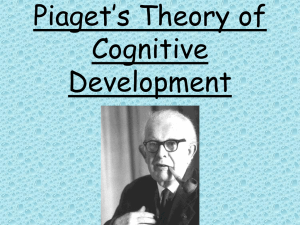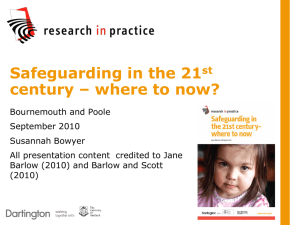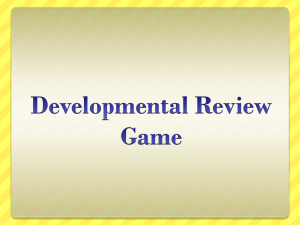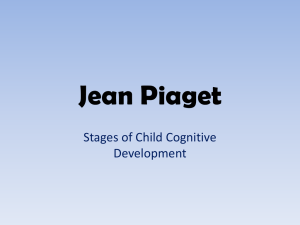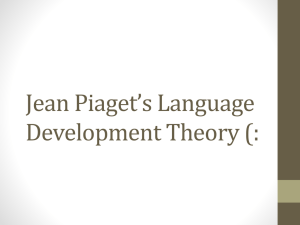Infancy and Childhood
advertisement
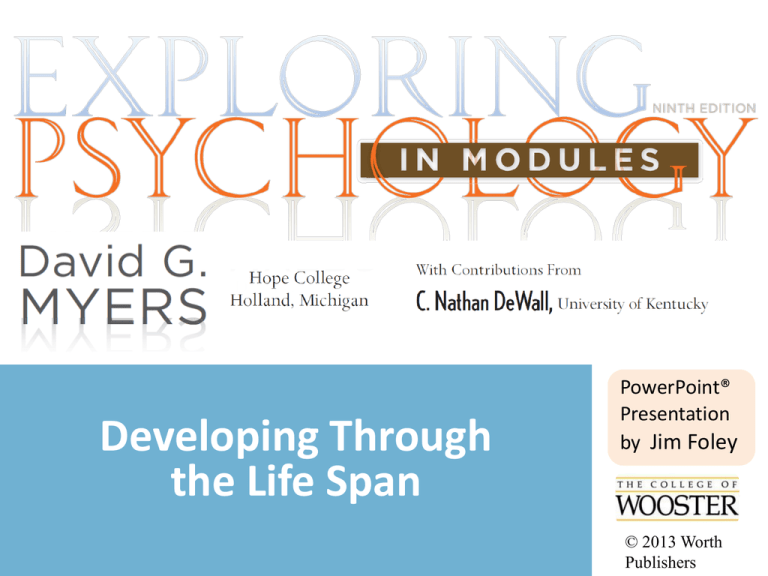
Developing Through the Life Span PowerPoint® Presentation by Jim Foley © 2013 Worth Publishers Module 10: Infancy and Childhood Aspects of starting to grow up Brain and Body Development/maturation Cognitive Development: Piaget, Vygotsky Sensorimotor, Preoperational, Concrete Operational, Formal Operational Stages Egocentrism, Theory of Mind, Autism Vygotsky: Mind in Social Context Social Development and Cultural Influences Attachment: Origins, Styles, Deprivation Day Care, Parenting Styles, Culture and Child rearing Infancy and Childhood Infancy: newborns growing almost into toddlers Childhood: toddlers growing almost into teenagers For each of these stages, we will study: brain development. motor development. cognitive development. social and emotional development. Maturation: not the meaning you might think In psychology, “maturation” refers to changes that occur primarily because of the passage of time. In developmental psychology, maturation refers to biologically-driven growth and development enabling orderly (predictably sequential) changes in behavior. Experience (nurture) can adjust the timing, but maturation (nature) sets the sequence. Maturation in infancy and early childhood affects the brain and motor skills. For example, infant bodies, in sequence, will lift heads, then sit up, then crawl, and then walk. Maturation, the biological unfolding, will be seen in: brain development. motor development. Brain Development: Building and Connecting Neurons In the womb, the number of neurons grows by about 750,000 new cells per minute in the middle trimester. Beginning at birth, the connections among neurons proliferate. As we learn, we form more branches and more neural networks. In infancy, the growth in neural connections takes place initially in the less complex parts of the brain (the brainstem and limbic system), as well as the motor and sensory strips. This enables body functions and basic survival skills. In early childhood, neural connections proliferate in the association areas. This enables advancements in controlling attention and behavior (frontal lobes) and also in thinking, memory, and language. Impact of Experience/Nurture on Brain Development The Process Continues into Adulthood Repeated practice at a finger-tapping task begins to activate a [slightly] larger group of motor neurons. Experience and Brain Development Rats living in an “enriched” environment (more social interaction and physical play) experienced a greater growth in brain size and complexity than those rats living in an “impoverished” environment. Motor Development Maturation takes place in the body and cerebellum enabling the sequence below. Physical training generally cannot change the timing. Baby Memory Infantile Amnesia In infancy, the brain forms memories so differently from the episodic memory of adulthood that most people cannot really recall memories from the first three years of life. A birthday party when turning three might be a person’s first memory. Learning Skills Infants can learn skills (procedural memories). This three month old can learn, and recall a month later, that specific foot movements move specific mobiles. Cognitive Development Cognition refers to the mental activities that help us function, including: problem-solving. figuring out how the world works. developing models and concepts. storing and retrieving knowledge. understanding and using language. using self-talk and inner thoughts. Cognitive Development: Jean Piaget (1896-1980) We don’t start out being able to think like adults. Jean Piaget studied the errors in cognition made by children in order to understand in what ways they think differently than adults. The error below is an inability to understand scale (relative size). Jean Piaget and Cognitive Development: Schemas An infant’s mind works hard to make sense of our experiences in the world. An early tool to organize those experiences is a schema, a mental container we build to hold our experiences. Schemas can take the form of images, models, and/or concepts. This child has formed a schema called “COW” which he uses to think about animals of a certain shape and size. “Cow!” “Cow!” Jean Piaget and Cognitive Development: Assimilation and Accommodation How can this girl use her “dog” schema when encountering a cat? She can assimilate the experience into her schema by referring to the cat as a “dog” or she can accommodate her animal schema by separating the cat, and even different types of dogs, into separate schemas. The Course of Development: Stages Jean Piaget believed that cognitive development: 1. is a combination of nature and nurture. Children grow by maturation as well as by learning through interacting/playing with the environment. 2. is not one continuous progression of change. Children make leaps in cognitive abilities from one stage of development to the next. Issue Nature vs. Nurture Continuity vs. Stages Jean Piaget’s Vote Both Stages Jean Piaget’s Stages of Cognitive Development Sensorimotor Stage (Birth to Age 2) In this stage, children explore by looking, hearing, touching, mouthing, and grasping. Cool cognitive trick learned at 6 to 8 months, coming up next: object permanence. There’s a game I’ve learned to play all by myself: peekaboo! Object Permanence Through games like “peekaboo,” kids learn object permanence--the idea that objects exist even when they can’t be seen. Hmm, a bear, should I put it in my mouth? Can Children Think Abstractly? Jean Piaget felt that kids in the sensorimotor stage did not think abstractly. Yet there is some evidence that kids in this stage can notice violations in physics (such as gravity). Does that mean babies are doing physics? Is This Math? If so, kids in the “sensorimotor” stage do math. Babies stare longer and with surprise when numbers don’t make sense. Is this math? Was Jean Piaget wrong? 20 Egocentrism: “I am the World.” Do you have a brother? Does Jim have a brother? Yes. Jim. No. How does this relate to egocentrism? What mistake is this boy making? What can kids do in the preoperational stage? 1. Represent their schema with words and images. 2. Perform pretend play. 3. Picture other points of view, replacing egocentrism with theory of mind. 4. Use intuition, but not logic and abstraction yet. Maturing beyond Egocentrism: Developing a “Theory of Mind” Theory of mind refers to the ability to understand that others have their own thoughts and perspective. With a theory of mind, you can picture that Sally will have the wrong idea about where the ball is. Examples of Operations that Preoperational Children Cannot Do…Yet Conservation refers to the ability to understand that a quantity is conserved (does not change) even when it is arranged in a different shape. Which row has more mice? Autism Spectrum Disorders Children with disorders on the autism spectrum have difficulties in three general areas: establishing mutual social interaction using language and play symbolically displaying flexibility with routines, interests, and behavior Children with disorders on the autism spectrum have more difficulty than a typical child in mentally mirroring the thoughts and actions of others; this difficulty has been called “mind blindness.” Happy train How do we teach social/emotional understanding to children with autism? Are the autistic kids learning to understand the emotions of others, or are they memorizing that certain facial positions correspond to certain emotion words? The Concrete Operational Stage begins at ages 6-7 (first grade) to age 11 children now grasp conservation and other concrete transformations they also understand simple mathematical transformations the reversibility of operations (reversing 3 + 7 = 10 to figure out that 10 - 7 = 3). Piaget’s stages of development Views and uses of Piaget’s Theory Although Jean Piaget’s observation and stage theory are useful, today’s researchers believe: 1. development is a continuous process. 2. children show some mental abilities at an earlier age than Piaget thought. 3. formal logic is a smaller part of cognition, even for adults, than Piaget believed. Piaget helps us understand kids fairly. 3 year olds: May break things without intending to; Cannot tell that they are blocking your view, much less figuratively see from your viewpoint on issues; May complain about a sibling getting more food if the same sized pizza was cut into more pieces. May not get your sarcasm. Lev Vygotsky: Alternative to Jean Piaget Lev Vygotsky studied kids too, but focused on how they learn in the context of social communication. Principle: children learn thinking skills by internalizing language from others and developing inner speech. Vygotsky saw development as building on a scaffold of mentoring, language, and cognitive support from parents and others. Social Development Stranger Anxiety Stranger anxiety develops around ages 9 to 13 months. In this stage, a child notices and fears new people. Explaining Stranger Anxiety How does this develop? As children develop schemas for the primary people in their lives, they are more able to notice when strangers do not fit those schemas. However, they do not yet have the ability to assimilate those faces. Why does this develop? An evolutionary psychologist would note that a child is learning to walk at this age. Some of the children who walked toward unfamiliar creatures might have died before having a chance to pass on genes. Social Development: Attachment Attachment refers to an emotional tie to another person. In children, attachment can appear as a desire for physical closeness to a caregiver. Origins of Attachment Experiments with monkeys suggest that attachment is based on physical affection and comfortable body contact, and not based on being rewarded with food. Origins of Attachment: Familiarity Most creatures tend to attach to caregivers who have become familiar. Birds have a critical period, hours after hatching, during which they might imprint: become rigidly attached to the first moving object they see. Attachment Variation: Styles of Dealing with Separation “Strange situations” test: 1. a mother and infant child are alone in an unfamiliar (“strange”) room; the child explores the room . 2. the mother leaves the room. 3. After a few moments, the mother returns. Reactions to Separation and Reunion Secure attachment: mild distress when mother leaves, seeking contact with her when she returns Insecure attachment (anxious style): not exploring, clinging to mother, loudly upset when mother leaves, remaining upset when she returns Insecure attachment (avoidant style): seeming indifferent to mother’s departure and return What causes these different attachment styles: nature or nurture? Is the “strange situations” behavior mainly a function of the child’s inborn temperament? Temperament refers to a person’s characteristic style and intensity of emotional reactivity. Some infants have an “easy” temperament happy, relaxed, and calm, with predictable rhythms of hunger and sleep. Some infants seem to be “difficult”; they are irritable, with unpredictable needs and behavior, and intense reactions. Is the child’s behavior actually caused by previous parenting behavior? Mary Ainsworth believed that sensitive, responsive, calm parenting is correlated with the secure attachment style. Training in sensitive responding for parents of temperamentally-difficult children led to doubled rates of secure attachment. Fathers Count Too Many studies of the impact of parenting have focused on mothers. Correlational studies show a strong relationship between paternal (father) involvement in parenting and the child’s academic success, health, and overall well-being. Influences on Separation Anxiety Effects of Environment on Attachment Separation anxiety peaks and fades whether kids are at home or in day care. Attachment Styles… not just about bonding with parents Erik Erikson’s concept of basic trust resembles the concept of attachment, but extends beyond the family into our feeling of whether the world is predictable and trustworthy. Attachment style may be relevant to our ability to manage and enjoy adult relationships. Are basic trust and attachment styles determined in childhood? Erik Erikson believed that basic trust is established by relationships with early caregivers. Are trust and attachment styles: set by genetics? formed by early experiences with parents? reshaped by new relationship experiences? Deprivation of Attachment If children live without safe, nurturing, affectionate caretaking, they may still be resilient, that is bounce back, attach, and succeed. However, if the child experiences severe, prolonged deprivation or abuse, he or she may: have difficulty forming attachments. have increased anxiety and depression. have lowered intelligence. show increased aggression. Children in Day Care We have seen already that time in day care does not significantly increase or decrease separation anxiety. Warm interaction with multiple caretakers can result in multiple healthy attachments. Time in day care correlates with advanced thinking skills… and also with increased aggression and defiance. Childhood: Parenting Styles Style Response to Child’s Behavior Authoritarian Parents impose rules “because I said so” “Too Hard” and expect obedience. Permissive Parents submit to kids’ desires, not enforcing “Too Soft” limits or standards for child behavior. Parents enforce rules, limits, and standards Authoritative but also explain, discuss, listen, and express “Just Right” respect for child’s ideas and wishes. Outcomes of these Parenting Styles Style Authoritarian “Too Hard” Permissive “Too Soft” Authoritative “Just Right” Long term outcomes for the child Rebellion, compulsivity, identity issues. Legal trouble, substance abuse, disorganization, unemployment. Internalized rules, self-discipline, follow through, life planning. Outcomes with Parenting Styles Authoritative parenting, more than the other two styles, seems to be associated with: high self-reliance. high social competence. high self-esteem. low aggression. But are these a result of parenting style, or are parents responding to a child’s temperament? Or are both a function of culture ? Or genes? Child-rearing: Cultural Differences Individualist cultures: raising children to be self-reliant, independent and developing a personal identity. In Western cultures, parents maintain control over parenting but might pay others to care for their children. Collectivist cultures, e.g. Asia and Africa: raising children to be interdependent, developing a family self (what shames the child, shames the family). Children in Africa and Asia are often raised in close physical contact with adults, but also raised later by siblings, integrated into webs of mutual support.



